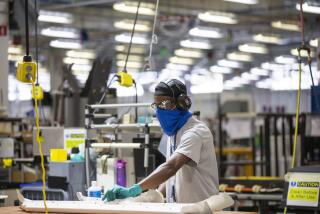3rd-Quarter Output Up a Slight 0.2% : Economy: A drop in the number of hours worked in the quarter may indicate a slowdown has been forcing businesses to use fewer employees.
- Share via
WASHINGTON — American workers’ productivity increased only slightly in the third quarter of 1990, rising at an annual rate of 0.2%, the government reported today.
The Labor Department’s report also showed that the number of hours worked fell 0.2% in the July-September period, the first such decline in four years.
Many analysts consider a decrease in hours worked a sign that the nation’s economic slowdown has been forcing businesses to make do with fewer employees.
In another report, the Commerce Department said that orders to U.S. factories jumped 2.8% in October, driven by transportation orders and rising energy prices.
The 0.2% third-quarter increase in non-farm productivity--defined as output per hour of work--was under the 0.3% rise in the second quarter of 1990 but better than the 1.3% plunge in productivity during the first quarter of 1990.
The mediocre increases of the last two quarters and the big decline of the first three months of the year mean that productivity has fallen at an annual rate of 0.2% thus far in 1990.
Increased productivity, or getting each worker to produce more during each hour of work, is considered vital to boosting the nation’s standard of living without inflation.
During all of 1989, productivity fell 0.7%.
Before the decline of 1989, productivity growth had averaged about 1.4% a year for the last several years, better than the 1.2% average of the 1970s but far worse than the 3.3% annual gain posted in the two decades after World War II.
In the factory report, the Commerce Department said orders for both durable and non-durable goods totaled a seasonally adjusted $250.7 billion after a revised 0.2% decline the previous month. The revision showed September orders even weaker than the 0.1% gain initially reported.
It was the largest increase since a 4% gain last April.
Factory orders are a key economic barometer of manufacturing industry plans for production. A decrease may forecast a slump in that sector and future layoffs.
More to Read
Inside the business of entertainment
The Wide Shot brings you news, analysis and insights on everything from streaming wars to production — and what it all means for the future.
You may occasionally receive promotional content from the Los Angeles Times.










